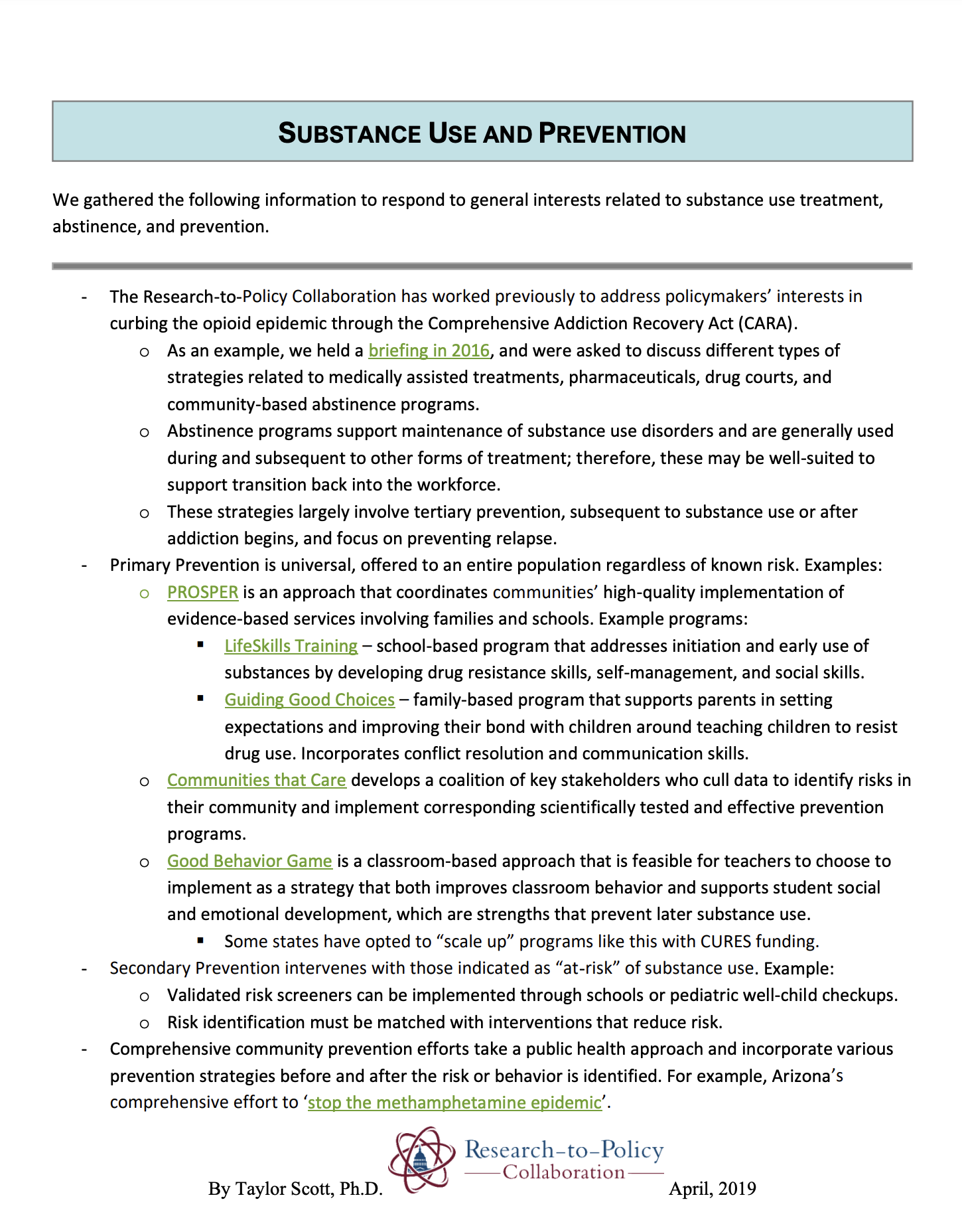
We gathered the following information to respond to general interests related to substance use treatment, abstinence, and prevention.
The Research-to-Policy Collaboration has worked previously to address policymakers’ interests in curbing the opioid epidemic through the Comprehensive Addiction Recovery Act (CARA).
- As an example, we held a briefing in 2016, and were asked to discuss different types of strategies related to medically assisted treatments, pharmaceuticals, drug courts, and community-based abstinence programs.
- Abstinence programs support maintenance of substance use disorders and are generally used during and subsequent to other forms of treatment; therefore, these may be well-suited to support transition back into the workforce.
- These strategies largely involve tertiary prevention, subsequent to substance use or after addiction begins, and focus on preventing relapse.
Primary Prevention is universal, offered to an entire population regardless of known risk. Examples:
- PROSPER is an approach that coordinates communities’ high-quality implementation of evidence-based services involving families and schools. Example programs:
- LifeSkills Training – school-based program that addresses initiation and early use of substances by developing drug resistance skills, self-management, and social skills.
- Guiding Good Choices – family-based program that supports parents in setting expectations and improving their bond with children around teaching children to resist drug use. Incorporates conflict resolution and communication skills.
- Communities that Care develops a coalition of key stakeholders who cull data to identify risks in their community and implement corresponding scientifically tested and effective prevention programs.
- Good Behavior Game is a classroom-based approach that is feasible for teachers to choose to implement as a strategy that both improves classroom behavior and supports student social and emotional development, which are strengths that prevent later substance use.
- Some states have opted to “scale up” programs like this with CURES funding.
Secondary Prevention intervenes with those indicated as “at-risk” of substance use. Example:
- Validated risk screeners can be implemented through schools or pediatric well-child checkups.
- Risk identification must be matched with interventions that reduce risk.
Comprehensive community prevention efforts take a public health approach and incorporate various prevention strategies before and after the risk or behavior is identified. For example, Arizona’s comprehensive effort to ‘stop the methamphetamine epidemic’.
The Research-to-Policy Collaboration (RPC) works to bring together research professionals and public officials to support evidence-based policy. Please visit their website to learn more.
Key Information
RPC Website
Research-to-Policy Collaboration
More RPC Resources
RPC Resources
Publication DateApril 1, 2019
Topic Area(s)Education and Child Development, Substance Use and Misuse
Resource TypeWritten Briefs
Share This Page
We gathered the following information to respond to general interests related to substance use treatment, abstinence, and prevention.
The Research-to-Policy Collaboration has worked previously to address policymakers’ interests in curbing the opioid epidemic through the Comprehensive Addiction Recovery Act (CARA).
- As an example, we held a briefing in 2016, and were asked to discuss different types of strategies related to medically assisted treatments, pharmaceuticals, drug courts, and community-based abstinence programs.
- Abstinence programs support maintenance of substance use disorders and are generally used during and subsequent to other forms of treatment; therefore, these may be well-suited to support transition back into the workforce.
- These strategies largely involve tertiary prevention, subsequent to substance use or after addiction begins, and focus on preventing relapse.
Primary Prevention is universal, offered to an entire population regardless of known risk. Examples:
- PROSPER is an approach that coordinates communities’ high-quality implementation of evidence-based services involving families and schools. Example programs:
- LifeSkills Training – school-based program that addresses initiation and early use of substances by developing drug resistance skills, self-management, and social skills.
- Guiding Good Choices – family-based program that supports parents in setting expectations and improving their bond with children around teaching children to resist drug use. Incorporates conflict resolution and communication skills.
- Communities that Care develops a coalition of key stakeholders who cull data to identify risks in their community and implement corresponding scientifically tested and effective prevention programs.
- Good Behavior Game is a classroom-based approach that is feasible for teachers to choose to implement as a strategy that both improves classroom behavior and supports student social and emotional development, which are strengths that prevent later substance use.
- Some states have opted to “scale up” programs like this with CURES funding.
Secondary Prevention intervenes with those indicated as “at-risk” of substance use. Example:
- Validated risk screeners can be implemented through schools or pediatric well-child checkups.
- Risk identification must be matched with interventions that reduce risk.
Comprehensive community prevention efforts take a public health approach and incorporate various prevention strategies before and after the risk or behavior is identified. For example, Arizona’s comprehensive effort to ‘stop the methamphetamine epidemic’.
The Research-to-Policy Collaboration (RPC) works to bring together research professionals and public officials to support evidence-based policy. Please visit their website to learn more.

Key Information
RPC Website
Research-to-Policy Collaboration
More RPC Resources
RPC Resources
Publication DateApril 1, 2019
Topic Area(s)Education and Child Development, Substance Use and Misuse
Resource TypeWritten Briefs
Share This Page
LET’S STAY IN TOUCH
Join the Evidence-to-Impact Mailing List
Keep up to date with the latest resources, events, and news from the EIC.




